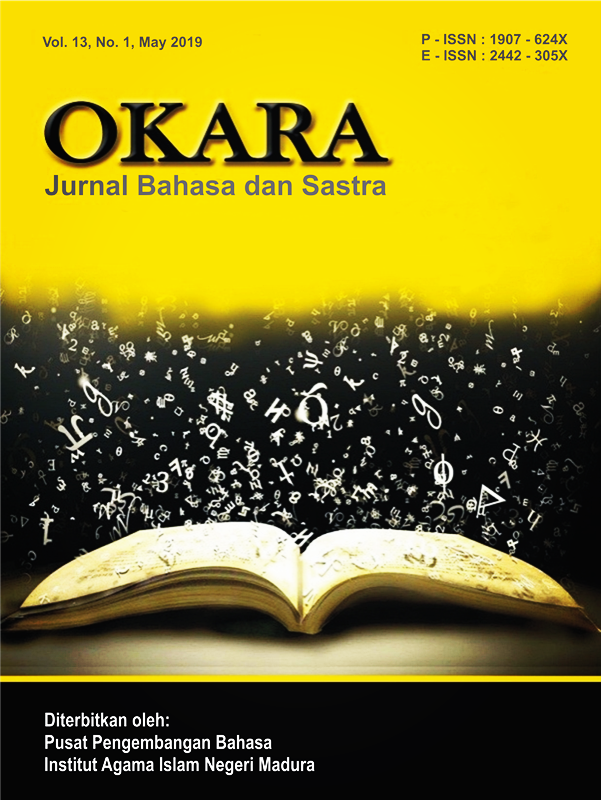Gog and Magog (Yakjuj wa Makjuj) Stories in Sundanese Manuscripts
 Abstract views: 515
,
Abstract views: 515
,
 PDF downloads: 330
PDF downloads: 330
Abstract
Gog and Magog will appear in the end of the world as a sign of doom. Their mysterious figure, making the story Gog and Magog interesting as well as a debate among experts. This study aims to reveal the reception of the Sundanese to the story of Gog and Magog which is represented by three Sundanese texts: Saifu Ad-Dharīb (SaD), Lajaj Dajal (LD), and Nawādirul 'Ulūm (NU). This study used a descriptive qualitative method with the reception theory approach. Of the three manuscripts, there are a diversity reception informing the advantages and disadvantages of each manuscript. The reception of who is Magog, LD's text calls them communist descendants. Regarding its existence, the SaD manuscripts say they are on Mount Qaf. Related to their numbers, the three manuscripts mention the numbers very much; SaD mentioned they have 400,000 troops, and each of them gave birth to 1000 offspring. NU's manuscripts reveal all objects will be destroyed and humans will become their prey. SaD's manuscripts mention their deaths due to massive winds; LD manuscripts say they died from being attacked by thousands of mosquitoes, while NU manuscripts say they died of disease.
Downloads
References
Al-Adnani, Abu Fatiah. Petaka Akhir Zaman: Detik-Detik Menuju Hari Kehancuran Alam Semesta. Surakarta: Granada Media Tama, 2016.
———. Petaka Akhir Zaman: Detik-Detik Menuju Hari Kehancuran Alam Semesta. Surakarta: Granada Media Tama, 2016.
Al-’Aziz, Muhammad Ahmad ’Abdu. An-Nihāyah Fitan Wa Ahwāl Ākhir Al-Zamān: Mukhtashar Nihāyat Al-Bidāyah Li Ibnu Katsir. Al-Qahirah: Maktabah al-Turāts al-Islamy, 1988.
Al-Hamid, Hisyam Kamal Abdu. Ya’jūj Wa Ma’jūj Qādimun. 1st ed. Al-Qāhirah: Dār al-Kitāb al-’Arabi, 2006.
Ali, Mahmud Athiyah Muhammad. Tanda Berakhirnya Dunia: Menyingkap Tabir Datangnya Kiamat Berdasarkan Al-Qur’an. Solo: Tinta Medina, 2014.
Al-Mubayyadh, Muhammad Ahmad. Al-Mausū’ah Fī Al-Fitan Wa Al-Malāhim Wa Asyarāti as-Sā’ati. Al-Qahirah: Muassasah Al-Mukhtār Li An-Nasyr wa At-Tauzī’, 2006.
Al-Qudsy, Musa Turoichan. Munculnya Dajjal Dan Imam Mahdi Di Akhir Zaman (Terjemah Fafirru Ila Allah). Pertama. Surabaya: Ampel Mulia Surabaya, 2004.
Al-’Uraifi, Muhammad bin Abdirrahman. Al-’ālam Al-Akhīr: Ahdāṡ Al-Qiyāmah as-Ṣugrā Wa Al-Kubrā Wa Mā Ba’dahā Bi as-Ṣuwar Wa Al-Tauḍīhāt Min Al-Qur’ān Wa as-Sunnah as-Ṣahīhah. Riyadh: Dar at-Tadmuriyyah, 2012.
Al-Wabil, Yusuf bin Abdillah bin Yusuf. “Asyrātu As-Sā’ati.” Dar Ibnu al-Jauzi, 1983.
Al-Walid, Mahmud Rajab Hamadi. Kasyfu Al-Minan Fī ’Alāmāti Al-Sā’ati Wa Al-Malāhim Wa Al-Fitan: Ru’yat Limustaqbal Al-’Alam Al-Islāmi Fī Dhau’i Al-Kitāb Wa Al-Sunnah. Beirut: Dār ibnu Hazim Li at-thibā’ah wa an-Nasyr wa at-Tauzi’, 2002.
———. Kasyfu Al-Minan Fī ’Alāmāti as-Sā’ati Wa Al-Malāhim Wa Al-Fitan: Ru’yat Limustaqbal Al-’ālam Al-Islāmi Fī Dhau’i Al-Kitāb Wa as-Sunnah. Beirut: Dar ibnu Hazim La aThiba’ah wa an-Nasyr wa at-Tauzii’, 2002.
As-Sa’labi, Mustafa Abu an-Nasr. Sahih Asyratu As-Sā’at Wa Wasfu Liyaumi Al-Ba’si Wa Ahwāli Yaumi Al-Qiyāmah. 2nd ed. Jeddah: Maktabah al-Sawāadi li al-Tauzi’, 1994.
As-Sufi, Mahir Ahmad. Asyrāt Al-Sā’ati Al-’Alāmāt Al-Kubrā. Beirut: Syirkah Abnā Syarīf al-Anshārī li al-Thibā’ah wa al-Nashr wa at-Tauzī’, 2010.
Bakri, Tubagus Ahmad. Saifu Ad-Dharīb. Purwakarta, 1922.
Baried, Baroroh. Pengantar Teori Filologi. Jakarta: BPFF UGM, 1994.
Dittmer, Jason. “Of Gog and Magog : The Geopolitical Visions of Jack Chick and Premillennial Dispensationalism.” ACME: An International E-Journal for Critical Geographies 6 (2007): 278–303.
Fatkhullah, Faiz Karim. “Saifu Aḍ - Ḍharīb : Text Edition and Study of Signs of Doomsday.” Universitas Padjadjaran, 2019.
Fatkhullah, Faiz Karim, Tajudin Nur, and Undang Ahmad Darsa. “The Reception Of Dajal Story In The Saifu Ad-Dharib.” Humanus 17, no. 1 (March 20, 2018): 37. https://doi.org/10.24036/humanus.v17i1.8779.
Fitriyani, Winda. “Naskah Layang Dajjal ‘Kebangkitan Makhluk Laknatullah’ Suntingan Teks Dan Terjemahan.” Universitas Padjadjaran, 2017.
Ghaits, Muhammad Ghaits bin. “Ahādis Asyrāth As-Sā’ati Wa Fiqhuhā.” Jami’ah Muhammad al-Khamis Mamlakah al-Garbiyyah Rabat, 2013.
“Hadis Shahih Muslim No. 169.” Accessed April 25, 2019. http://www.carihadis.com/lihat.php?kitab=Shahih_Muslim&id=1.
Jabrohim. Metodologi Penelitian Sastra. Edited by Jabrohim. 3rd ed. Yogyakarta: PT Hanindita Graha Widya, 2003.
Lee, Lydia. “The Enemies Within : Gog of Magog Modern Political Identifications of Gog.” HTS Teologiese Studies/Theological Studies 73, no. 3 (2017): 1–7.
Muslim, Abi al-Husain bin al-Hajjaj bin. Sahih Muslim. Riyadh: Dar al-Salam Li al-Nashr wa al-Tauzi’, 2000.
Mutaqin, Imam Cici. “Naskah Nawadirul Ulum ‘Tanda-Tanda Hari Kiamat’: Edisi Teks Dan Terjemahan.” Universitas Padjadjaran, 2016.
Pérez, Sandra Sáenz-lópez. “La Representacion De Gog y Magog.” AEA LXXVIII, no. 311 (2005): 263–76.
Railton, Nicholas M . “Gog and Magog : The History of a Symbol.” The Evangelical Quarterty 1 (2003): 23–43.
Robson, S.O. Prinsip-Prinsip Filologi Indonesia. Jakarta: Pusat Pembinaan dan Pengembangan Bahasa dan Universitas Leiden, 1994.
Salim, Ach. Ghazali. “Peran Kitab Suci Al- Qur’an.” OKARA 1, no. X (2015): 1–16.
Teeuw, A. Sastra Dan Ilmu Sastra. 5th ed. Bandung: Pustaka Jaya, 2015.
Winarno, Hery H. “Burung Garuda, Dewa Atau Elang Jawa | Merdeka.Com,” 2017. https://www.merdeka.com/khas/burung-garuda-dewa-atau-elang-jawa.html.
Winarno, Hery H. “Https://Www.Merdeka.Com/Khas/Burung-Garuda-Dewa-Atau-Elang-Jawa.Html.” Merdeka.com, 2017.
The journal operates an Open Access policy under a Creative Commons Attribution-NonCommercial 4.0 International License. Authors who publish with this journal agree to the following terms:
- Authors retain copyright and grant the journal right of first publication with the work simultaneously licensed under a Creative Commons Attribution License that allows others to share the work with an acknowledgement of the work's authorship and initial publication in this journal.
- Authors are able to enter into separate, additional contractual arrangements for the non-exclusive distribution of the journal's published version of the work (e.g., post it to an institutional repository or publish it in a book), with an acknowledgement of its initial publication in this journal.
- Authors are permitted and encouraged to post their work online (e.g., in institutional repositories or on their website) prior to and during the submission process, as it can lead to productive exchanges, as well as earlier and greater citation of published work.





_(1).png)
.png)
.png)
1.png)
.png)
.png)

.png)
_-_Copy_-_Copy.png)





